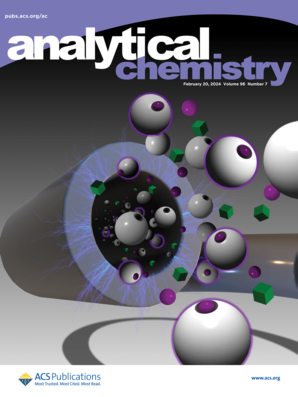调节电子接受强度的零荧光探针用于联氨的超灵敏特异检测
IF 6.7
1区 化学
Q1 CHEMISTRY, ANALYTICAL
引用次数: 0
摘要
激发态分子内质子转移(ESIPT)过程的引入对设计具有特定功能的零背景荧光探针具有重要意义。本文根据N2H4的亲核攻击特性,通过调节二氰乙烯对取代基的电子接受能力以及羟基与二氰乙烯的相对位置,设计了一系列以二氰乙烯为识别位点的bdmn探针。研究发现,更强的电子接受能力可以大大提高识别位点的反应活性,并且只有当羟基位于识别位点的邻取代基上时,探针才能与N2H4反应生成腙作为质子受体,产生ESIPT过程和蓝绿色荧光发射。以Br为电子接受基的探针m-Br-OH-BDMN对N2H4具有较好的检测性能,检测限低(LOD为0.46 nM),响应快(1 s),即使在18种干扰存在下也具有较好的选择性。此外,通过构建m-Br-OH-BDMN负载硅基多孔传感器,实现对N2H4蒸气的特异性识别,进一步验证了探头设计策略的实用性。本文提出的非荧光探针设计策略将为功能探针的合理设计和高性能传感方法提供新的思路。本文章由计算机程序翻译,如有差异,请以英文原文为准。

Zero- Fluorescence Probe for Ultrasensitive and Specific Detection of Hydrazine by Regulating the Electron-Accepting Strength
The introduction of an excited-state intramolecular proton transfer (ESIPT) process is of great significance for the design of zero-background fluorescent probes with specific functionalities. Here, based on the nucleophilic attack characteristics of N2H4, a series of BDMN-based probes with dicyanoethylene as the recognition site were designed by regulating the electron-accepting ability of para-substituent of the dicyanoethylene and the relative position of the hydroxyl group and dicyanoethylene. It is found that a stronger electron-accepting capability could greatly improve the reactivity of the recognition site, and only when the hydroxyl group is in the ortho-substituent of the recognition site, the probe could react with N2H4 to generate hydrazone as a proton acceptor, producing the ESIPT process and the blue-green fluorescence emission. The probe m-Br–OH-BDMN with Br as the electron-accepting group has better detection performance for N2H4, with low limit of detection (LOD, 0.46 nM), fast response (1 s), and superior selectivity even in the presence of 18 kinds of interferents. Furthermore, the practicability of the probe design strategy was further verified by the construction of a m-Br–OH-BDMN loaded silicon-based porous sensor, realizing the specific identification of N2H4 vapor. The present nonfluorescent probe design strategy would provide new thoughts for the rational design of functional probes as well as high-performance sensing methodologies.
求助全文
通过发布文献求助,成功后即可免费获取论文全文。
去求助
来源期刊

Analytical Chemistry
化学-分析化学
CiteScore
12.10
自引率
12.20%
发文量
1949
审稿时长
1.4 months
期刊介绍:
Analytical Chemistry, a peer-reviewed research journal, focuses on disseminating new and original knowledge across all branches of analytical chemistry. Fundamental articles may explore general principles of chemical measurement science and need not directly address existing or potential analytical methodology. They can be entirely theoretical or report experimental results. Contributions may cover various phases of analytical operations, including sampling, bioanalysis, electrochemistry, mass spectrometry, microscale and nanoscale systems, environmental analysis, separations, spectroscopy, chemical reactions and selectivity, instrumentation, imaging, surface analysis, and data processing. Papers discussing known analytical methods should present a significant, original application of the method, a notable improvement, or results on an important analyte.
 求助内容:
求助内容: 应助结果提醒方式:
应助结果提醒方式:


